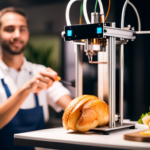Revolutionizing the culinary landscape, 3D food printing stands as a groundbreaking solution for individuals with dietary restrictions and health conditions.
This innovative technology not only offers a tantalizing array of custom-tailored meals but also presents a pioneering approach to addressing complex nutritional needs.
From allergen-free delicacies to personalized nutrient-packed creations, the potential of 3D printed food to transform the way we eat is truly remarkable.
Understanding Dietary Restrictions
Understanding dietary restrictions is essential for effectively managing food-related health conditions and ensuring proper nutrition. Individuals with dietary restrictions must navigate their dietary needs carefully to avoid allergens and maintain optimal health. Allergens, such as peanuts, tree nuts, dairy, eggs, wheat, soy, fish, and shellfish, can trigger severe immune responses in affected individuals. It is crucial for individuals to be able to identify and understand these allergens to prevent adverse reactions.
Moreover, dietary needs vary greatly among individuals based on factors such as age, gender, activity level, and existing health conditions. For instance, individuals with diabetes may need to monitor their carbohydrate intake, while those with celiac disease must avoid gluten-containing foods. Understanding these specific dietary needs is crucial for tailoring meal plans and ensuring that individuals receive adequate nutrition while avoiding harmful substances.
Advantages of 3D Printed Food
3D printed food offers precise customization of food products to meet specific dietary needs and health conditions. This innovative technology presents several advantages that revolutionize the food industry and benefit consumers:
-
Culinary creativity:
3D food printing allows chefs and food manufacturers to unleash their creativity by producing intricate designs and unique textures that were previously impossible to achieve with traditional methods. This opens up new possibilities for creating visually stunning and appealing dishes that enhance the overall dining experience. -
Sustainable production:
3D printing reduces food waste by using precise amounts of ingredients, minimizing excess and optimizing resources. This sustainable approach aligns with the growing demand for eco-friendly and efficient food production practices, contributing to a more environmentally conscious industry. -
Personalized nutrition:
With 3D printing, it becomes feasible to tailor food products to individuals’ specific dietary requirements, including allergies, intolerances, and nutritional needs. This level of customization ensures that consumers can enjoy safe, healthy, and personalized meals, addressing various health conditions and preferences effectively.
These advantages position 3D printed food as a game-changer in the food industry, offering a new realm of possibilities for culinary innovation and addressing dietary restrictions and health conditions.
Customized Nutrition Solutions
Customized nutrition solutions offer tailored dietary options to address specific health conditions and dietary restrictions through food 3D printing technology. This advanced technology allows for the creation of personalized diets that cater to individuals with unique nutritional needs, such as those with food allergies, intolerances, or specific health conditions. By utilizing 3D printing technology, customized nutrition solutions can provide precise control over the composition of food, ensuring that individuals receive the necessary nutrients while avoiding ingredients that may be detrimental to their health.
| Key Benefits of Customized Nutrition Solutions | |
|---|---|
| Personalized Diets | Tailored to individual nutritional requirements |
| Enhanced Compliance | Increases adherence to dietary restrictions |
| Improved Health Outcomes | Supports management of specific health conditions |
| Nutrient Optimization | Ensures adequate intake of essential nutrients |
| Enhanced Quality of Life | Promotes overall well-being through customized nutrition plans |
These personalized dietary options not only promote better health outcomes but also enhance the overall quality of life for individuals with dietary restrictions or health conditions. Customized nutrition solutions represent a significant advancement in the field of nutrition, offering a new approach to addressing individual dietary needs.
Addressing Health Conditions
To address health conditions, food 3D printing technology enables precise customization of dietary options. This innovative approach leverages health technology to provide personalized medicine through food. Here are three key ways food 3D printing is addressing health conditions:
-
Tailored Nutrient Profiles: Food 3D printing allows for the creation of meals with specific nutrient compositions, catering to the dietary needs of individuals with health conditions such as diabetes, hypertension, or malnutrition.
-
Texture Modification: For individuals with swallowing difficulties or oral sensitivity due to health conditions like dysphagia or oral cancer, food 3D printing can modify the texture of food, ensuring it meets their specific requirements.
-
Allergen-Free Options: Food 3D printing can produce allergen-free meals for individuals with food allergies or intolerances, ensuring they can enjoy a wide variety of foods without compromising their health.
Future Implications and Innovations
Moving forward, the intersection of food and health technology is poised to yield further advancements in addressing dietary restrictions and health conditions, with the potential to significantly enhance personalized dietary solutions. Future applications of 3D food printing are expected to revolutionize the way individuals with dietary restrictions and health conditions approach their meals. One of the most anticipated technological advancements is the development of 3D food printers capable of producing customized meals tailored to an individual’s specific dietary needs. This innovation holds the promise of offering individuals with restricted diets a wider variety of food options that align with their nutritional requirements.
Moreover, the impact on sustainability is another area that holds promise. With advancements in 3D food printing, there is potential to reduce food waste by precisely controlling the ingredients and portions used in food production. This could lead to a more sustainable food system by minimizing overproduction and excess consumption.
Additionally, the cultural implications of 3D food printing are noteworthy. As this technology becomes more accessible, it has the potential to reshape traditional culinary practices, offering new ways to prepare and present culturally significant dishes while accommodating dietary restrictions.
Frequently Asked Questions
What Are the Limitations of 3D Printed Food in Terms of Texture and Taste for People With Dietary Restrictions?
Texture modification and taste enhancement in 3D printed food present challenges for people with dietary restrictions. Achieving the desired texture and taste while adhering to specific dietary requirements requires precision and innovation in food 3D printing technology.
How Does 3D Printed Food Cater to Individuals With Multiple Dietary Restrictions or Complex Health Conditions?
Customized options in 3D printed food cater to individuals with multiple dietary restrictions or complex health conditions by providing tailored nutritional requirements. This cost-effective and sustainable production method offers a solution to diverse dietary needs.
Are There Any Potential Risks or Side Effects Associated With Consuming 3D Printed Food for Individuals With Specific Health Conditions?
Potential risks and side effects associated with consuming 3D printed food for individuals with specific health conditions include allergenic reactions, nutritional imbalances, and texture discrepancies. Understanding these concerns is crucial for ensuring the safety of 3D printed food.
Can 3D Printed Food Be Customized to Accommodate Cultural or Religious Dietary Restrictions?
In the realm of 3D food printing, the potential for cultural adaptation and catering to religious considerations is promising. Customization can be achieved by adjusting ingredients and designs, offering a new dimension to dietary accommodation.
What Are the Ethical Considerations Surrounding the Use of 3D Printed Food for Individuals With Dietary Restrictions and Health Conditions?
When examining the ethical considerations of utilizing 3D printed food for individuals with dietary restrictions and health conditions, it is essential to address the potential health implications, technological limitations, and the need for transparent regulation.
Conclusion
In conclusion, food 3D printing offers innovative solutions for individuals with dietary restrictions and health conditions. The ability to customize nutrition and address specific health needs has the potential to revolutionize the way we approach food consumption.
For example, a recent study found that 3D printed meals tailored to individuals with diabetes resulted in better blood sugar control and overall improved health outcomes.
As technology continues to advance, the implications and innovations of 3D printed food are promising for the future of personalized nutrition.


